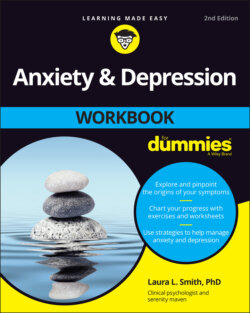Читать книгу Anxiety and Depression Workbook For Dummies - Laura L. Smith - Страница 13
Plotting Your Personal Problems Profile
ОглавлениеThe Personal Problems Profile provides you with an overview of your problematic symptoms. (If you skipped the quizzes in the previous sections of this chapter, go back and take the time to complete them; your answers to those quizzes come into play in this exercise.) The profile exercise in this section helps you identify the ways in which anxiety and depression affect you. One good thing about this profile is that you can track how these symptoms change as you progress through the rest of this book.
Tyler, a middle-aged chemical engineer, doesn’t consider himself depressed or plagued with any emotional problems. But when he sees his primary care doctor, Tyler complains of fatigue, recent weight gain, and a noticeable loss in his sex drive. These feelings predated the pandemic but became more noticeable while he was quarantined. After ruling out physical causes, the doctor suggests that he may be depressed. He reluctantly agrees to meet with a social worker.
When Tyler fills out his Personal Problems Profile (see Worksheet 1-10), he lists the following top ten symptoms and notes whether they indicate anxiety or depression (A or D).
As you can see, Tyler suffers primarily from symptoms of depression. And most of these symptoms are physical in nature. Filling out his Personal Problems Profile helps Tyler see that he has a depression he wasn’t even consciously aware of. He reflects on his discovery (see Worksheet 1-11).
This is the Anxiety & Depression Workbook For Dummies. You can’t feel better without doing a little work. Don’t worry; the work isn’t that difficult. Of course, you can skip a few exercises, but the more of them you complete, the sooner you’ll start feeling better. Odd as it may seem, writing things down does a world of good. Writing helps you remember, clarifies your thinking, and increases focus and reflection.
Worksheet 1-10 Tyler’s Personal Problems Profile
| 1. I have no energy lately. (D)2. Every move I make takes more effort lately. (D)3. I’ve lost my sex drive. (D)4. I’ve been eating all the time lately. (D)5. I don’t feel like being with anyone. (D)6. I don’t look forward to much of anything. (D)7. I find it impossible to make decisions. (D)8. I worry about my health all the time. (A)9. I feel shaky all over. (A)10. Sometimes I can’t make myself get out of bed. (D) |
Worksheet 1-11 Tyler’s Reflections
| I can see that I do have signs of depression. I didn’t realize that before. And I see that depression particularly shows up in my body. It’s affecting my energy, sex drive, and appetite. It’s also making me withdraw from my girlfriend, which I can see from my loss of sex drive and lack of desire to be with her. Apparently, I also have a few symptoms of anxiety, and I think I always have. It’s time to do something about this. |
Complete your own Personal Problems Profile in Worksheet 1-12. Look back at the quizzes earlier in this chapter and underline the most problematic thoughts, feelings, behaviors, and relationship issues you have. Then choose up to ten of the most significant items you’ve underlined and write them in the My Personal Problems Profile space that’s provided.
In addition, put an A by the symptoms that are most indicative of anxiety (even-numbered items in the preceding quizzes) and a D by symptoms that are most consistent with depression (odd-numbered items).
Do your symptoms mostly involve anxiety, depression, or a mix of the two? And do they seem to mostly affect your thoughts, feelings, behaviors, or relationships? Take some time to reflect on your profile. What conclusions can you draw? Record them in Worksheet 1-13.
Worksheet 1-12 My Personal Problems Profile
| 1. |
| 2. |
| 3. |
| 4. |
| 5. |
| 6. |
| 7. |
| 8. |
| 9. |
| 10. |
Worksheet 1-13 My Reflections
